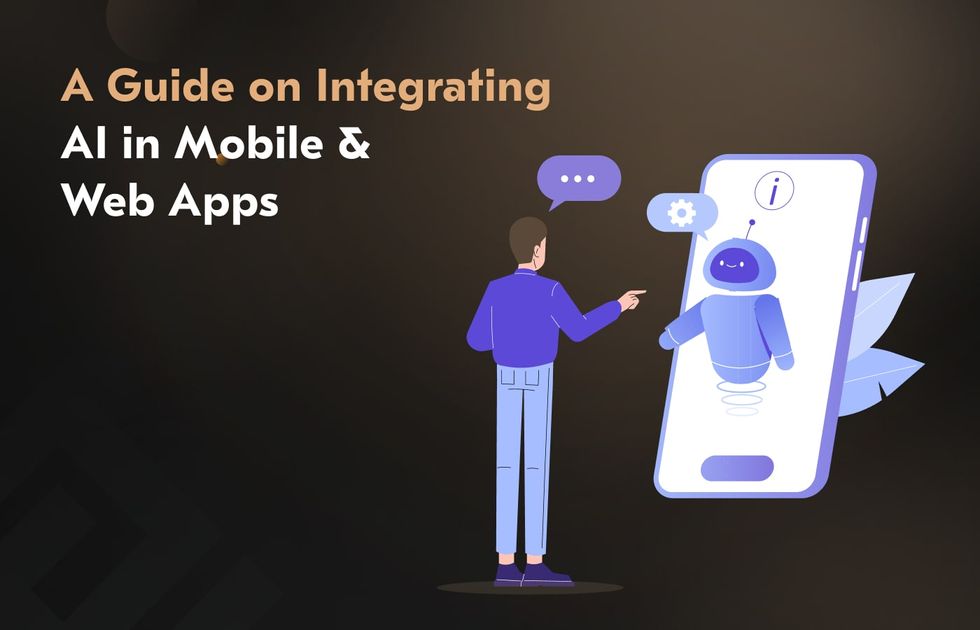
Key Takeaways
- AI adoption in apps is surging, with the market forecasted to grow from $28B in 2025 to $354B by 2034, driven by increasing demand for personalized, responsive digital experiences.
- As of recent reports, 78% of companies have integrated AI applications in business apps for at least one function, showing a strong presence across industries.
- Businesses with $500+ million in annual revenue are applying generative AI across more departments than their smaller counterparts.
- AI models improve over time with use, making them ideal for apps expecting to scale from hundreds to thousands of users without performance drops.
When OpenAI introduced its intelligent chatbot services and attracted 100 million users in just a month, it completely redefined the digital landscape. In 2024, 230 million people used AI applications. Today, giants like Amazon, Apple, and Google employ artificial intelligence for business applications, investing in their own AI-based products to remain competitive.
Besides automating technical processes and simplifying operational routines, AI adds immense value to how users interact with apps. They can resolve issues, find answers, and enjoy advanced functionality powered by sophisticated models.
Standing among the best AI software developers, Acropolium has been implementing smart AI/ML algorithms for custom web and mobile solutions for 6+ years. Today, we want to show you how to integrate AI into an app and how it reimagines functionality with real-world examples and our success cases.
Why Use AI for App Development or Modernization?
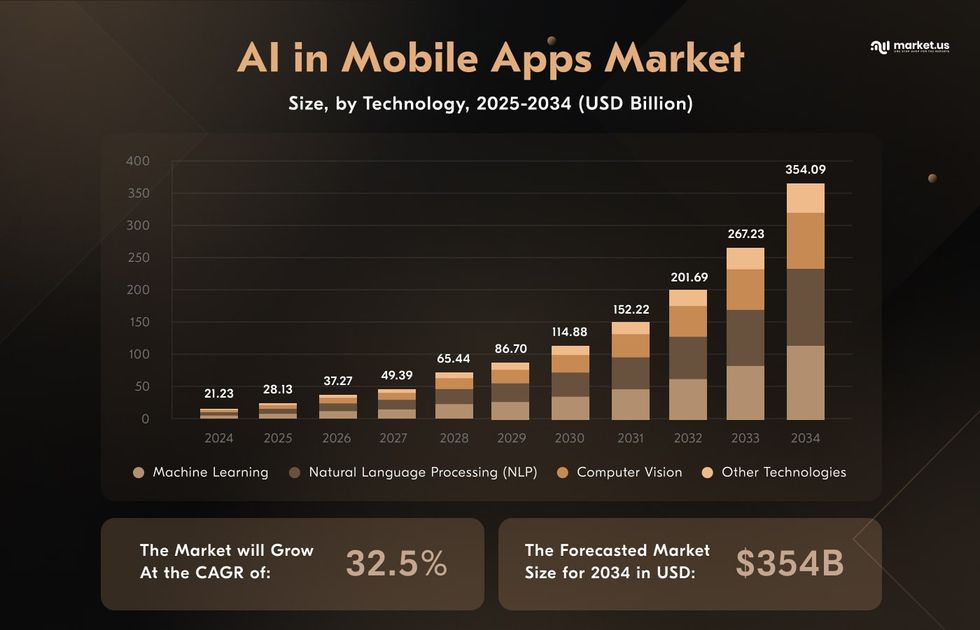
Users expect more than just a good-looking interface. They want smart, responsive experiences. Integrating artificial intelligence in mobile apps or web solutions means it can actually learn from how people use it, offering personalized content, smarter recommendations, and even predicting what a user might need next.
As smartphones get more powerful and AI tools get better, it’s becoming easier to build apps that not just react but adapt. Whether it’s artificial intelligence for business applications or AI-based platform development for regular users, the technology can help it feel smarter, faster, and more relevant.
The AI-in-apps market It’s expected to jump from about $28 billion in 2025 to a massive $354 billion by 2034 at a CAGR of 32%.
Artificial Intelligence in Mobile Apps: Integration Examples
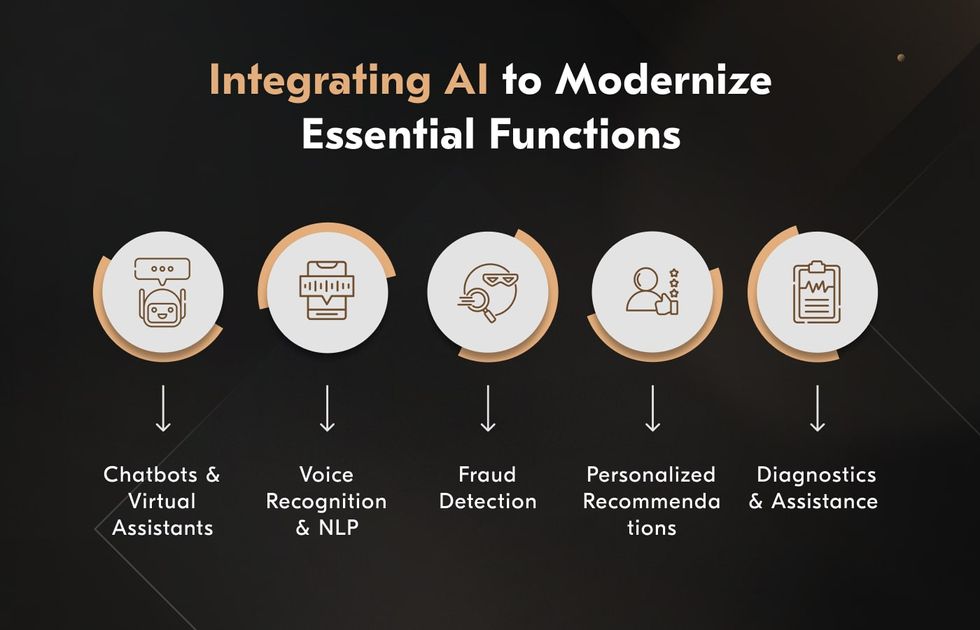
Most organizations are using generative AI for mobile apps and digital products, most often in marketing and sales. However, how they apply it in other areas depends a lot on the industry. Companies tend to focus on areas where gen AI can bring the biggest benefits.
For instance, media and telecom companies use it in customer service, tech companies use AI in SaaS development, and professional services firms use it for managing knowledge and information.
The size of a company also makes a difference. Larger companies (with over $500 million in annual revenue) are using gen AI across more departments than smaller businesses. Still, every business determines how to incorporate AI into apps based on their objectives.
AI-powered Chatbots and Virtual Assistants
Virtual assistants enhance user interactions by providing instant support and automating routine inquiries. In banking, apps like Bank of America’s Erica assist users with balance checks, transaction summaries, and financial advice through a conversational interface.
Chatbots help reduce customer service response times, free up human agents for complex issues, and ensure consistent service delivery around the clock.
Voice Recognition and Natural Language Processing (NLP)
Voice-based interfaces have become integral to modern applications, which let users interact with their devices more naturally. With artificial intelligence in mobile apps, products Siri and Alexa can comprehend spoken language, perform tasks, and provide timely information. In smart home systems, these capabilities enable users to control lighting, temperature, and security with voice commands.
Moreover, for users with disabilities, voice-enabled apps provide greater independence and accessibility.
Live Fraud Detection & Risk Management
Financial services platforms such as PayPal and Stripe employ machine learning models that detect anomalies and suspicious behavior patterns. By continuously analyzing user activity and transaction histories, these systems can flag potential fraud instantly, helping to safeguard user accounts while maintaining a seamless user experience.
Personalized Recommendations
One of the most visible ways of how to integrate AI into an app for better user engagement is through personalized content. Recommendation engines powered by AI analyze browsing behavior, purchase history, and engagement metrics to suggest relevant products, services, or media.
Platforms like Netflix recommend shows tailored to individual viewing habits, while Amazon curates product selections based on past purchases. Travel apps use similar technology to suggest destinations, accommodations, or activities based on user preferences and behavior patterns.
Healthcare Diagnostics & Assistance
AI applications in businesses from the healthcare sectors assess medical data and support early diagnosis. For instance, SkinVision uses computer vision to evaluate images of skin lesions and identify potential cancer risks to suggest next steps.
This also reduces the burden on healthcare professionals by allowing preliminary screening to be conducted via smartphone. Similar solutions help monitor chronic conditions, interpret fitness data, and support teleconsultations, leading to faster, more accurate care.
Benefits of Artificial Intelligence for Business Applications
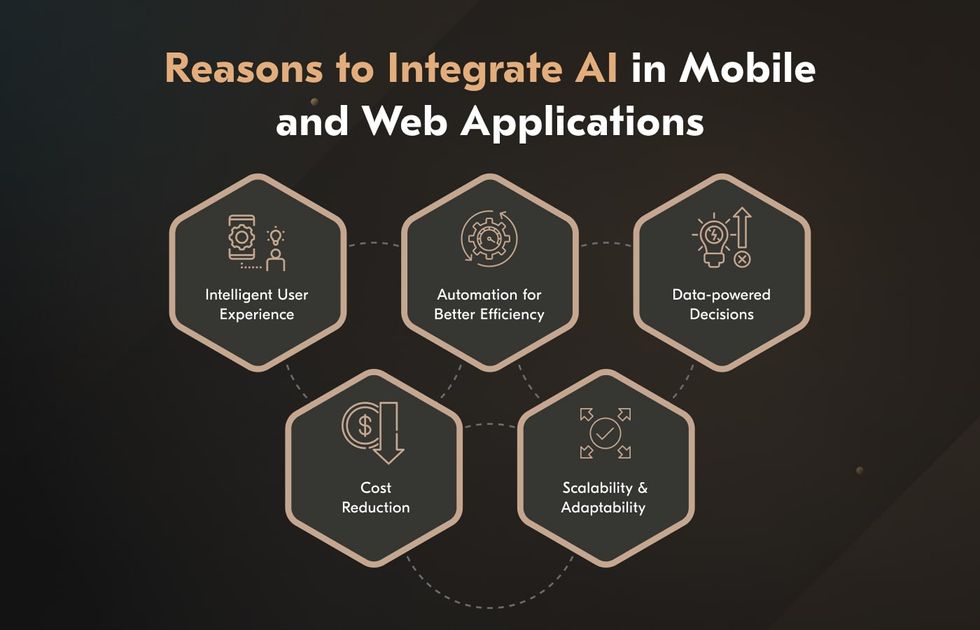
According to McKinsey, 78% of companies have adopted AI for at least one business function. At the same time, about 21% of people whose companies use generative AI say it’s already changed the way some of their workflows are designed from the ground up.
While most of them use artificial intelligence for enterprise applications, intelligent modules can also bring advantages to smaller companies and startups. As AI becomes more common in everyday tools and tasks, it’s also becoming a valuable asset for startups building software applications.
Here are some of the key ways AI integration can make the development process faster, smarter, and more efficient.
Intelligent User Experience
With real-time learning and behavior analysis, AI helps your app respond to each user in a way that feels intuitive, natural, and relevant. It can be a personalized product suggestion or an interface that adapts to how someone interacts — AI will turn a standard app experience into something more seamless, personal, and human.
Greater Efficiency with Automation
From handling routine support tickets to generating content suggestions or even summarizing long texts, automation saves time and keeps processes running smoothly behind the scenes. Similar to enterprise-level operations, AI applications for small businesses reduce manual work and lower the chances of errors, preserving your focus on tasks that require actual brainpower.
Data-Powered Decision-Making
As your product gathers tons of data, AI for app development helps to make sense of it. Instead of just collecting numbers, you’re now uncovering patterns, trends, and insights that inform your strategy. With the right tools in place, you can act faster, smarter, and more confidently. It can be adjusting features, testing new ideas, or spotting what works and what doesn’t.
Cost Reduction with Fewer Manual Tasks
Manual processes require time and money. AI gives you a way out. From smarter resource allocation to predictive maintenance and energy optimization, AI derives insights and cuts unnecessary costs while keeping operations balanced.
Fewer outages, faster response times, and less need for constant human oversight make the workflow more optimized and, hence, less expensive.
Scalability through Self-Learning Systems
The beauty of AI applications in business products is that they get better with time. As your user base grows, AI in web and app solutions learn, adapt, and scale without requiring constant rework. This means your app remains just as effective and efficient at 1,000 users as it is at 10,000 — with the right implementation, of course.
Application of AI in Businesses Across Industries

While the number of AI use cases in different industries grows exponentially, for mobile and web applications the sky is the limit. With automation, real-time analysis, and personalization being top purposes of the technology, there are many ways of how to add AI to your app.
Let’s explore how they differ from industry to industry and how they are similar.
Retail & E-commerce
AI tailors online shopping experiences and improves operational planning. It interprets customer behavior in real-time, driving smarter product recommendations, optimizing search, and forecasting demand with precision.
Zalando, the European fashion platform, uses machine learning to personalize product feeds and generate outfit suggestions based on individual style preferences. On the backend, AI helps them manage stock levels and automate pricing strategies.
Shopify also enables sellers to integrate AI-driven features like customer segmentation and smart product discovery directly into their stores.
Healthcare
Applications of AI in businesses from the medical sector improve diagnostics, assist in early detection, and support patient self-assessment. It helps doctors process data faster and make more informed decisions, especially in resource-constrained environments.
Babylon Health provides AI-powered health consultations, using algorithms to analyze symptoms and suggest next steps. SkinVision also uses artificial intelligence in mobile apps, offering their users a tool to assess skin spots for potential risk.
Finance & Fintech
Banks and fintech platforms use AI to detect anomalies, evaluate creditworthiness, and provide financial advice with speed and scale. These systems are constantly learning from user behavior to improve accuracy and reduce risk.
Meanwhile, tools for finance and portfolio management like Cleo and Wealthfront offer users automated insights on spending, budgeting, and saving while functioning as digital financial coaches.
Transportation & Logistics
AI supports supply chain operations using live data to reduce inefficiencies, predict disruptions, and improve delivery accuracy. Artificial intelligence for business applications in logistics is also vital for coordinating high-volume transport networks where timing and cost margins are tight.
DHL applies AI to plan optimal delivery routes and forecast shipment volumes. Also, Uber relies on machine learning for ride-matching, pricing, and precise ETA calculation.
Hospitality
Hotels and travel platforms apply AI to refine pricing strategies, personalize guest interactions, and better understand traveler preferences.
Hilton introduced Connie, an AI concierge that interacts with guests and provides information about local attractions and services. Leading booking platforms like Booking also use artificial intelligence in mobile apps to adjust rates dynamically based on behavior, location, and seasonality.
Real Estate
AI tools in real estate are streamlining the search process, estimating market values more precisely, and making it easier to match buyers with relevant properties.
Zillow integrates AI to improve its home value estimations and recommend listings. Redfin uses ML-based filters to help users refine their search results based on nuanced criteria.
Education & EdTech
Adaptive learning technologies are making education more responsive to individual progress and learning styles. AI in edtech also powers writing assistants, plagiarism detection, and automated feedback systems.
Duolingo employed artificial intelligence in mobile app development to adapt language lessons based on how each user learns. Coursera leverages AI to recommend content and build personalized course paths. Last but not least, Grammarly uses AI to offer grammar, clarity, and tone feedback in seconds.
Media & Entertainment
AI helps media companies analyze consumption patterns, forecast trends, and curate content for specific audiences. It plays a central role in how modern platforms retain users.
TikTok’s feed is governed almost entirely by AI, learning from user interaction patterns. Spotify uses deep learning to generate hyper-personalized playlists.
Manufacturing
Smart factories rely on AI for quality control, performance monitoring, and predictive maintenance. These systems reduce waste, downtime, and human error while increasing throughput.
Siemens is a great example of a company that adopts artificial intelligence for enterprise applications. The leading manufacturer uses advanced models in industrial automation to anticipate equipment failures. Similarly, Bosch uses AI-powered visual inspection systems to detect defects in real-time, improving quality assurance without slowing down operations.
Choosing the Right AI Solutions for Your Needs
When integrating AI into your product, an early and important decision involves choosing between off-the-shelf tools and a custom-built solution.
Each option offers distinct advantages, and the most suitable one depends on your specific objectives, desired level of flexibility, and long-term vision for the product.
If you’re solving a generic problem with standard requirements, off-the-shelf tools may be enough. But if your vision involves differentiated experiences, complex logic, or long-term scalability, investing in a custom AI solution supported by a dedicated development team is the more strategic and future-proof choice.
A dedicated team helps you:
- Translate abstract goals into technical plans and comprehensive discovery phases.
- Validate your ideas through prototyping and MVPs that will show how to incorporate AI into apps the right way.
- Build responsibly, with a focus on performance, data security, and explainability.
- Adapt quickly as your data and user needs evolve.
Overcoming Challenges in AI Integration
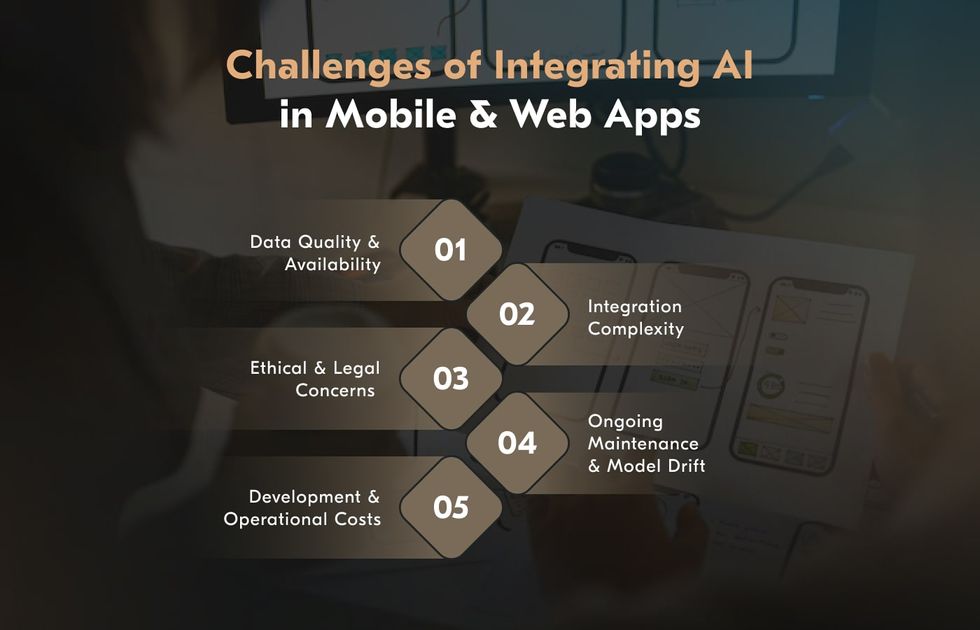
While using artificial intelligence for business applications can bring many life-changing advantages, the process is not without its complexities. Here are some of the most common challenges organizations face:
Data quality and availability. AI systems rely on well-organized data. Incomplete, inconsistent, or poorly labeled datasets can limit the accuracy and reliability of AI models, reducing their effectiveness within the application as a result.
Integration complexity. Seamlessly integrating AI into legacy or monolithic architectures can be a technically demanding process. Transitioning to the cloud or more flexible structures, such as microservices, can help.
Ethical and legal considerations. The use of AI raises important ethical questions, including concerns about algorithmic bias, data privacy, and transparency. Plus, organizations must ensure compliance with evolving legal and regulatory frameworks, especially when handling sensitive user information.
Ongoing maintenance and model drift. AI models require continuous monitoring and updating to maintain performance. Over time, models may become less accurate due to changing user behavior or outdated training data, also known as data drift.
Development and operational costs. How much does it cost to integrate AI into an app? AI implementation often involves significant initial investment, along with ongoing expenses for infrastructure, development, and maintenance. You should plan accordingly to ensure sustainability and consistent ROI.
How to Integrate AI into an App? Key Steps
Before delving into the process of integrating AI into an app, it is important to understand the broader framework. Although business leaders may not handle the technical implementation directly, having a general overview supports informed decision-making.
Here is a concise breakdown of the main steps involved in AI integration:
Define your business needs. Determine the specific challenges or goals AI can address, such as improving customer service or automating internal operations.
Select the right AI tools and technologies. Choose from existing platforms (e.g., ChatGPT APIs) or develop custom models depending on data sensitivity, cost, and complexity.
Assemble the right team. Engage experts such as data scientists, ML engineers, and developers to manage development, training, and deployment.
Collect and prepare data. Gather relevant, high-quality data from internal and external sources. Clean and structure it to ensure reliable model outcomes.
Train and fine-tune models. Use your prepared dataset to train or fine-tune the selected AI model to align with your app’s objectives.
Integrate and test. Incorporate the AI model into your app’s infrastructure via APIs, followed by comprehensive testing to ensure seamless performance.
Monitor and optimize. Continuously evaluate AI performance post-launch and refine models to adapt to evolving user behavior or data patterns.
Why Choose Acropolium as a Reliable AI App Development Team?
Acropolium brings over 20 years of experience delivering high‑impact custom software solutions. Our development processes are ISO‑certified, while the dedicated teams ensure consistent quality and proactive risk management.
When implementing artificial intelligence for business applications, we follow GDPR‑compliant practices for your resilience. With Acropolium’s dedicated teams handling end‑to‑end AI integration, you stay focused on strategy while we build intelligent apps that deliver value.
Acropolium’s Case Studies
Custom Omni-Channel Retail Solution with AI
A multi‑channel retailer needed to unify e‑commerce, brick‑and‑mortar, and mobile sales under a single, real‑time platform. Acropolium delivered a cloud‑based solution featuring AI‑driven inventory synchronization, predictive analytics, and automated workflows, which resulted in:
- 25% faster order fulfillment
- 22% increase in customer satisfaction
- 18% growth in overall revenue
AI-based Predictive Analytics Tool for Healthcare
A rapidly expanding hospital network struggled with staff scheduling and equipment allocation. After a comprehensive audit, we built a GDPR- and HIPAA‑compliant predictive analytics system. It forecasts patient demand, automates shift planning, and optimizes resource use, while also delivering:
- 25% boost in operational efficiency
- 30% reduction in patient wait times
- 15% uplift in staff satisfaction
Final Thoughts
Advanced learning models have become embedded in the DNA of modern software. AI applications in business are reshaping how users interact with apps and changing the way systems make decisions.
As businesses seek faster, more informed ways to serve customers and respond to change, integrating AI becomes a practical step toward staying relevant. And Acropolium is here to help, valuing your goals and budget with our subscription-based services.
Reach out and share your objectives — we will show you how to add AI to your app and get the most out of it!









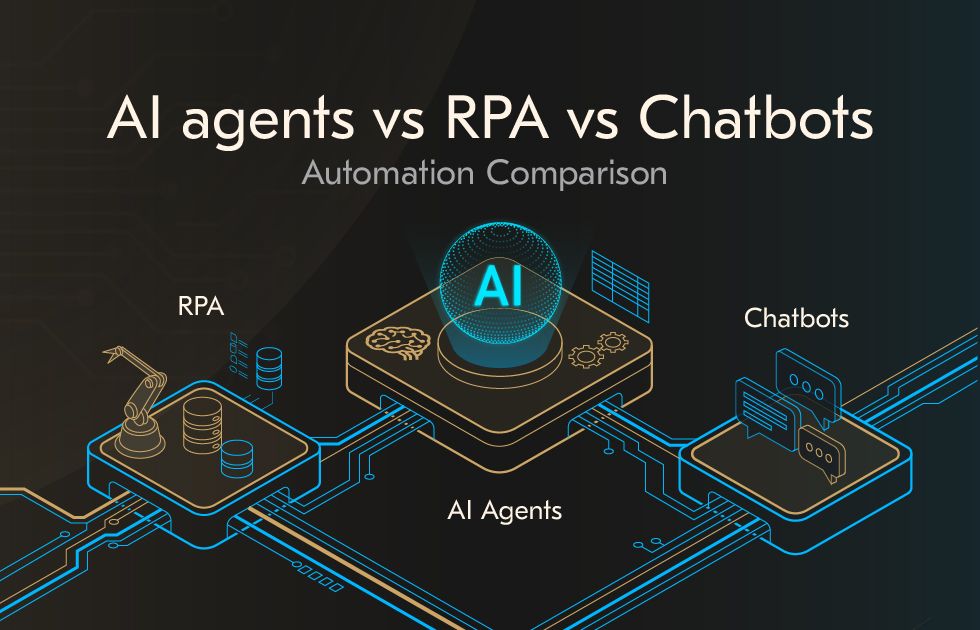
![AI in Retail: [Use Cases & Applications for 2025]](/img/articles/ai-in-retail-use-cases/img01.jpg)


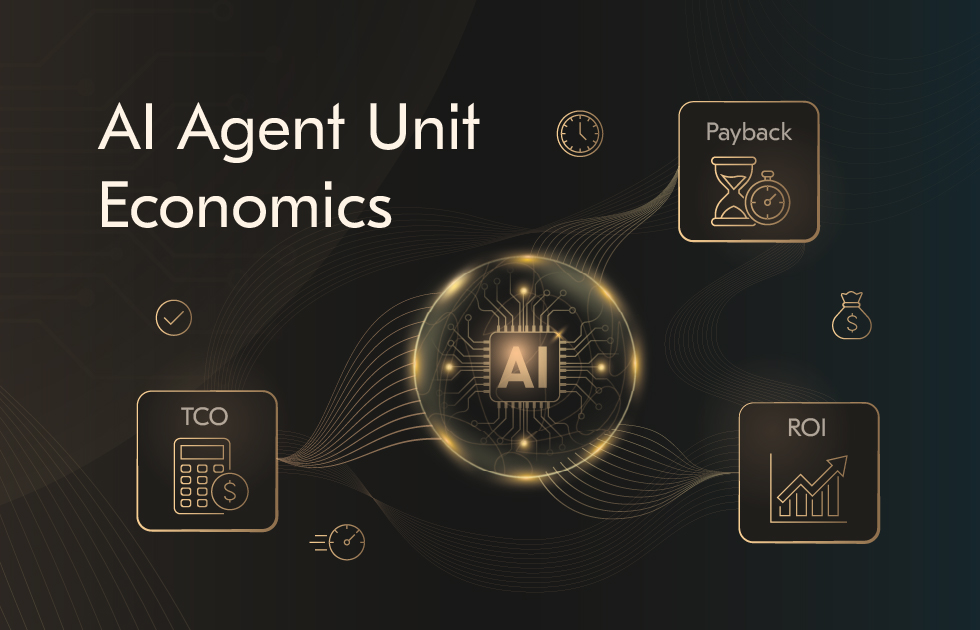
![6 AI Use Cases in Education in 2025: [Benefits & Applications]](/img/articles/6-ai-use-cases-in-education-transforming-the-learning-experience/img01.jpg)